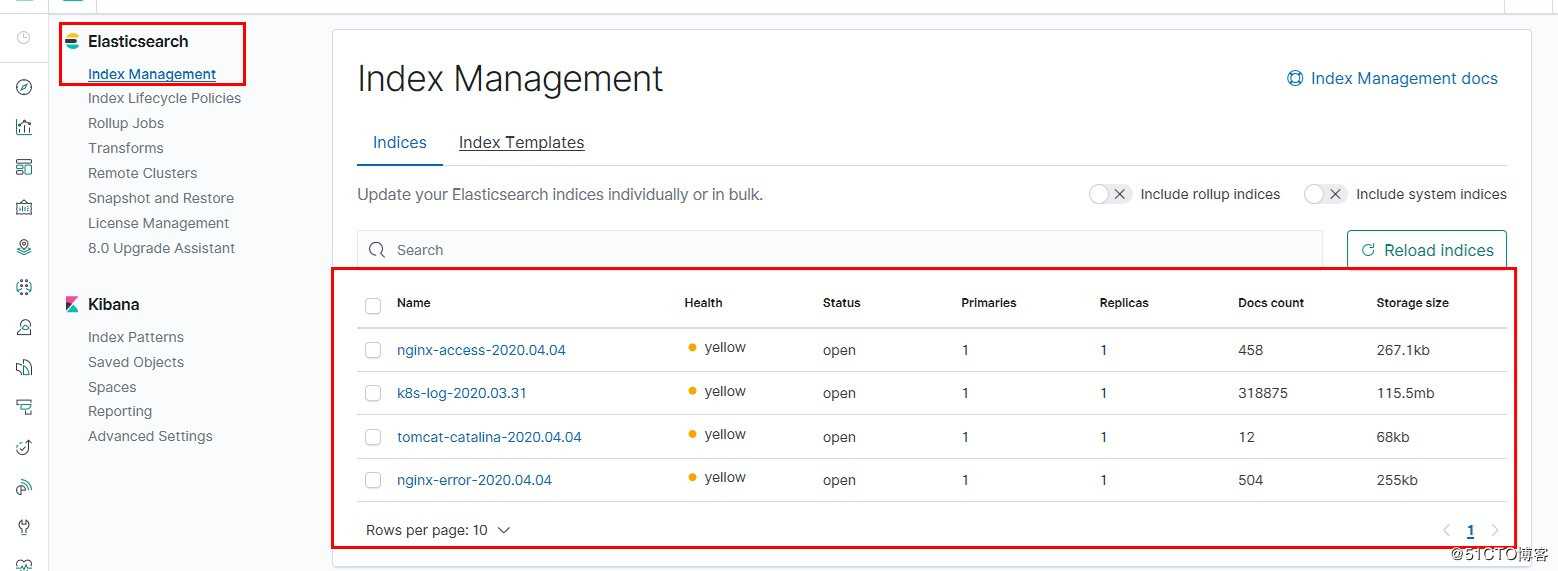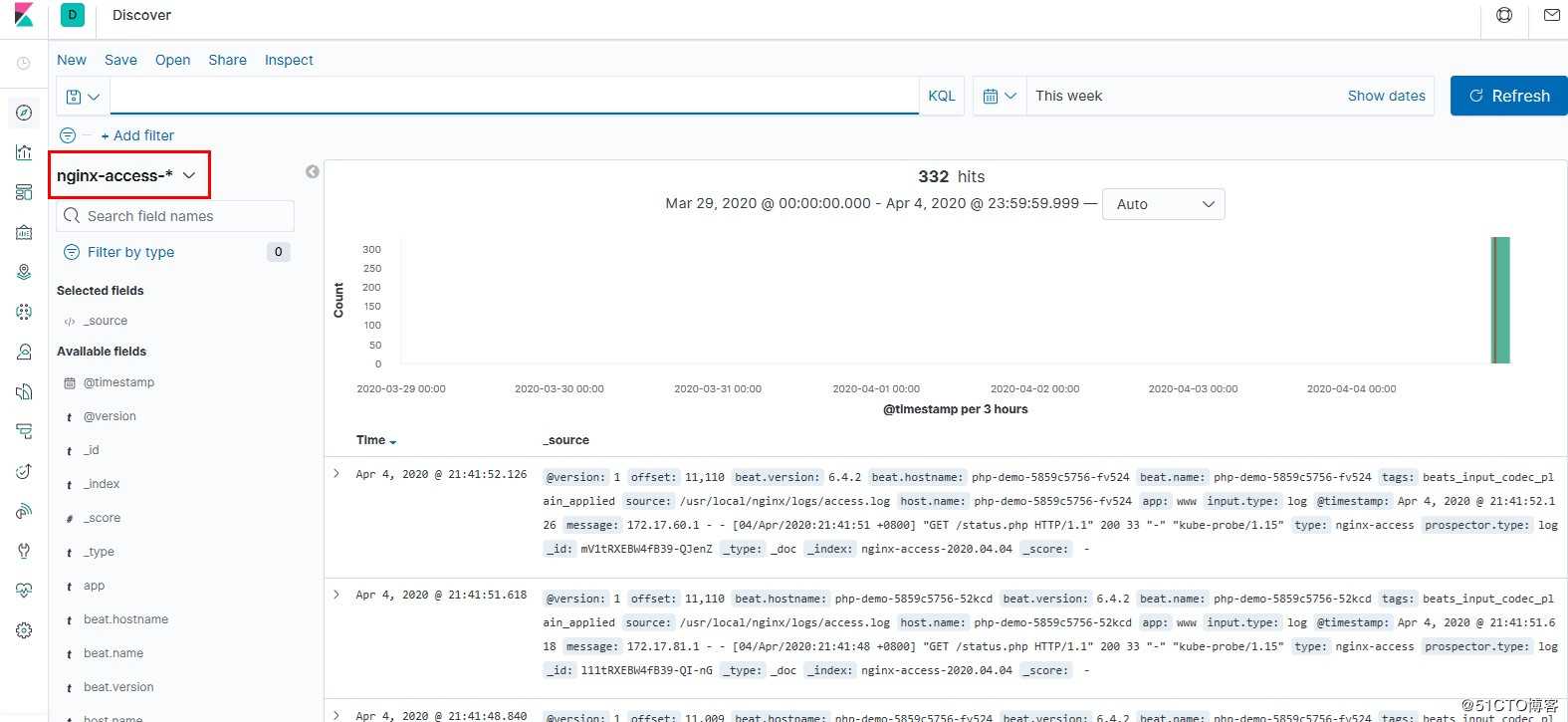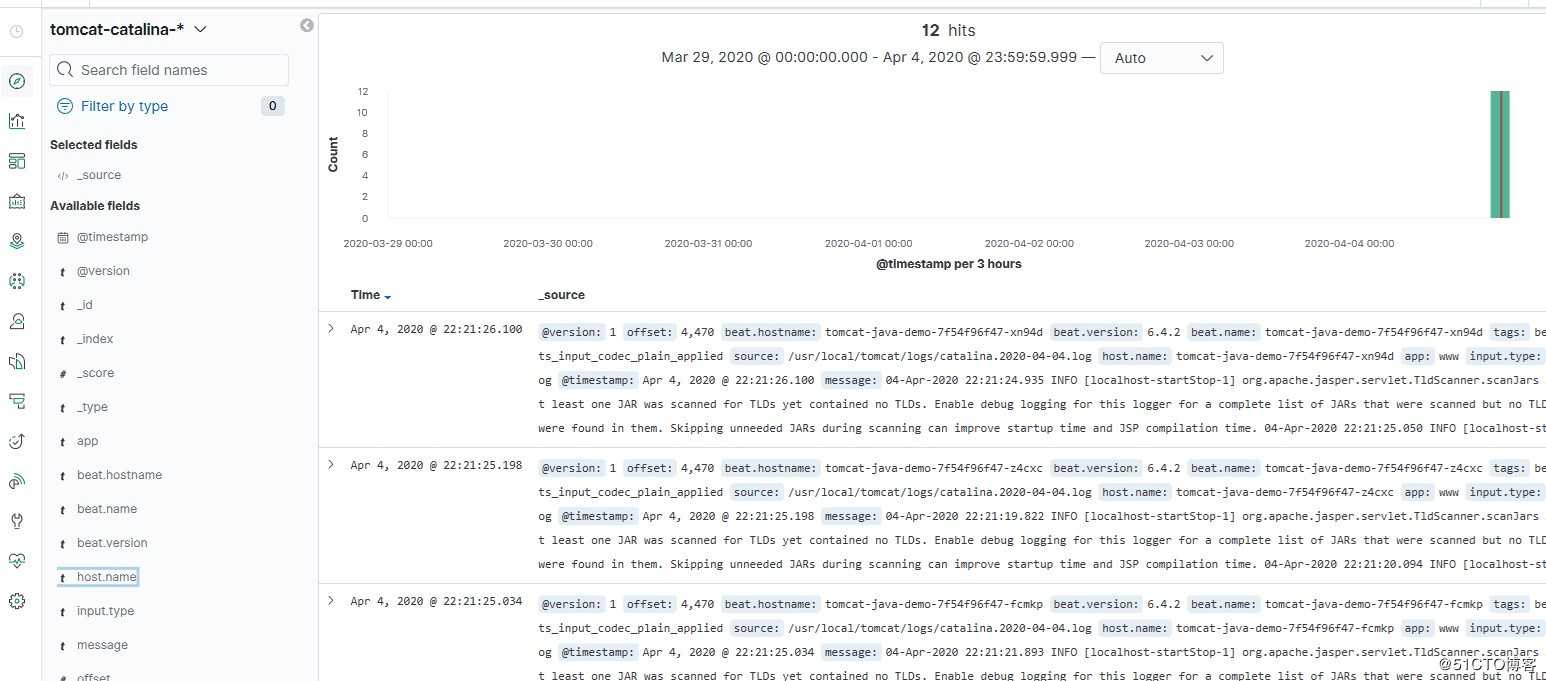k8s集群日志收集
Posted
tags:
篇首语:本文由小常识网(cha138.com)小编为大家整理,主要介绍了k8s集群日志收集相关的知识,希望对你有一定的参考价值。
k8s集群日志收集-
收集哪些日志
K8S系统的组件日志
K8S Cluster里面部署的应用程序日志 - 日志方案 Filebeat+ELK
Filebeat(日志采集工具)+Logstach(数据处理引擎)+Elasticserch(数据存储、全文检索、分布式搜索引擎)+Kibana(展示数据、绘图、搜索)
3 容器中的日志怎么收集
收集方案:Pod中附加专用日志收集的容器
优点:低耦合
缺点:每个Pod启动一个日志收集代理,增加资源消耗和运维维护成本
4 部署DaemonSet采取k8s组件日志/var/log/messages
4.1 ELK安装在harbor节点
安装、配置ELK
1)安装openjdk
yum -y install java-1.8.0-openjdk
2)安装Logstash
https://www.elastic.co/guide/en/logstash/7.6/installing-logstash.html
配置网络源
/etc/yum.repos.d/logstash.repo
[logstash-7.x]
name=Elastic repository for 7.x packages
baseurl=https://artifacts.elastic.co/packages/7.x/yum
gpgcheck=1
gpgkey=https://artifacts.elastic.co/GPG-KEY-elasticsearch
enabled=1
autorefresh=1
type=rpm-md
3)安装ELK组件
yum -y install logstash elasticsearch kibana
4)配置组件
修改kibana配置
vi /etc/kibana/kibana.yml
server.port: 5601
server.host: "0.0.0.0"
elasticsearch.hosts: ["http://localhost:9200"]
修改logstash配置
vi /etc/logstash/conf.d/logstash-to-es.conf
input {
beats {
port => 5044
}
}
filter {
}
output {
elasticsearch {
hosts => ["http://127.0.0.1:9200"]
index => "k8s-log-%{+YYYY.MM.dd}" #索引格式
}
stdout { codec => rubydebug }
}
启动服务
systemctl start kibana #启动kibana
systemctl start elasticsearch #启动elasticsearch
/usr/share/logstash/bin/logstash -f /etc/logstash/conf.d/logstash-to-es.conf &
192.168.1.143:5601 #访问kibana
5) 创建pod(master节点执行)收集组件日志
kubectl apply -f k8s-logs.yaml
apiVersion: v1
kind: ConfigMap
metadata:
name: k8s-logs-filebeat-config
namespace: kube-system
data:
filebeat.yml: |-
filebeat.prospectors:
-
type: log
paths:- /messages
fields:
app: k8s
type: module
fields_under_root: true
output.logstash:
hosts: [‘192.168.1.143:5044‘] - /messages
apiVersion: apps/v1
kind: DaemonSet
metadata:
name: k8s-logs
namespace: kube-system
spec:
selector:
matchLabels:
project: k8s
app: filebeat
template:
metadata:
labels:
project: k8s
app: filebeat
spec:
containers:
- name: filebeat
image: docker.elastic.co/beats/filebeat:6.4.2
args: [
"-c", "/etc/filebeat.yml",
"-e",
]
resources:
requests:
cpu: 100m
memory: 100Mi
limits:
cpu: 500m
memory: 500Mi
securityContext:
runAsUser: 0
volumeMounts:- name: filebeat-config
mountPath: /etc/filebeat.yml
subPath: filebeat.yml - name: k8s-logs
mountPath: /messages
volumes:
- name: filebeat-config
- name: k8s-logs
hostPath:
path: /var/log/messages
type: File - name: filebeat-config
configMap:
6)kibana添加索引
kibana界面->Index Patterns-》k8s-log-*->@timestamp->Create index pattern->Discover
7)查看日志

6 收集nginx日志
1)创建名称空间
cat namespace.yaml
apiVersion: v1
kind: Namespace
metadata:
name: test
2)创建pod的configmap(保存filebeat的配置文件)
kubectl apply -f filebeat-nginx-configmap.yaml
cat filebeat-nginx-configmap.yaml
apiVersion: v1
kind: ConfigMap
metadata:
name: filebeat-nginx-config
namespace: test
data:
filebeat.yml: |-
filebeat.prospectors:
-
type: log
paths:- /usr/local/nginx/logs/access.log
fields: #添加额外字段,表示字段来源和类型,日志收集时做配置
app: www
type: nginx-access
fields_under_root: true #将收集的日志放在kibana界面顶级
- /usr/local/nginx/logs/access.log
-
type: log
paths:- /usr/local/nginx/logs/error.log
fields:
app: www
type: nginx-error
fields_under_root: true
output.logstash: #收集的日志数据输出到logstash中
hosts: [‘192.168.1.143:5044‘] - /usr/local/nginx/logs/error.log
3)创建secret用于保存harbor用户的密码
kubectl create secret docker-registry harborsecret123 --docker-server=192.168.1.143 --docker-username=‘zhanghai‘ --docker-password=‘123@Abcde‘ -n test
4)修改logstash配置
/usr/share/logstash/bin/logstash -f /etc/logstash/conf.d/logstash-to-es.conf &
cat logstash-to-es.conf
input {
beats {
port => 5044
}
}
filter {
}
output {
if [app] == "www" {
if [type] == "nginx-access" {
elasticsearch {
hosts => ["http://127.0.0.1:9200"]
index => "nginx-access-%{+YYYY.MM.dd}"
}
}
else if [type] == "nginx-error" {
elasticsearch {
hosts => ["http://127.0.0.1:9200"]
index => "nginx-error-%{+YYYY.MM.dd}"
}
}
else if [type] == "tomcat-catalina" {
elasticsearch {
hosts => ["http://127.0.0.1:9200"]
index => "tomcat-catalina-%{+YYYY.MM.dd}"
}
}
else if [app] == "k8s" {
if [type] == "module" {
elasticsearch {
hosts => ["http://127.0.0.1:9200"]
index => "k8s-log-%{+YYYY.MM.dd}"
}
}
}
}
}
5)创建nginx的pod
kubectl apply -f nginx-deployment.yaml
cat nginx-deployment.yaml
apiVersion: apps/v1beta1
kind: Deployment
metadata:
name: php-demo
namespace: test
spec:
replicas: 3
selector:
matchLabels:
project: www
app: php-demo
template:
metadata:
labels:
project: www
app: php-demo
spec:
imagePullSecrets:
- name: harborsecret123
containers: -
name: nginx
image: 192.168.1.143/project/php-demo:latest
imagePullPolicy: Always
ports:- containerPort: 80
name: web
protocol: TCP
resources:
requests:
cpu: 0.5
memory: 256Mi
limits:
cpu: 1
memory: 1Gi
resources:
requests:
cpu: 0.5
memory: 256Mi
limits:
cpu: 1
memory: 1Gi
livenessProbe:
httpGet:
path: /status.php
port: 80
initialDelaySeconds: 6
timeoutSeconds: 20
volumeMounts: - name: nginx-logs
mountPath: /usr/local/nginx/logs
- containerPort: 80
-
name: filebeat
image: docker.elastic.co/beats/filebeat:6.4.2
args: [
"-c", "/etc/filebeat.yml",
"-e",
]
resources:
limits:
memory: 500Mi
requests:
cpu: 100m
memory: 100Mi
securityContext:
runAsUser: 0
volumeMounts:- name: filebeat-config
mountPath: /etc/filebeat.yml
subPath: filebeat.yml -
name: nginx-logs
mountPath: /usr/local/nginx/logsvolumes:
- name: filebeat-config
- name: nginx-logs
emptyDir: {} - name: filebeat-config
configMap:
name: filebeat-nginx-config

5)配置kibana前台
kibana界面->Kibana Index Patterns-》nginx-access-*->@timestamp->Create index pattern->Discover

- 收集tomcat日志
1)创建pod的configmap
cat filebeat-tomcat-configmap.yaml
apiVersion: v1
kind: ConfigMap
metadata:
name: filebeat-config
namespace: test
data:
filebeat.yml: |-
filebeat.prospectors:
- type: log
paths:- /usr/local/tomcat/logs/catalina.*
fields:
app: www
type: tomcat-catalina
fields_under_root: true
multiline: #多行匹配,已[开头为记录一行日志
pattern: ‘^[‘
negate: true
match: after
output.logstash:
hosts: [‘192.168.1.143:5044‘]
kubectl apply -f filebeat-tomcat-configmap.yaml
- /usr/local/tomcat/logs/catalina.*
2)创建tomcat的pod
kubectl apply -f tomcat-deployment.yaml
cat tomcat-deployment.yaml
apiVersion: apps/v1beta1
kind: Deployment
metadata:
name: tomcat-java-demo
namespace: test
spec:
replicas: 3
selector:
matchLabels:
project: www
app: java-demo
template:
metadata:
labels:
project: www
app: java-demo
spec:
imagePullSecrets:
- name: harborsecret123
containers: -
name: tomcat
image: 192.168.1.143/project/tomcat-java-demo:latest
imagePullPolicy: Always
ports:- containerPort: 8080
name: web
protocol: TCP
resources:
requests:
cpu: 0.5
memory: 1Gi
limits:
cpu: 1
memory: 2Gi
livenessProbe:
httpGet:
path: /
port: 8080
initialDelaySeconds: 60
timeoutSeconds: 20
readinessProbe:
httpGet:
path: /
port: 8080
initialDelaySeconds: 60
timeoutSeconds: 20
volumeMounts: - name: tomcat-logs
mountPath: /usr/local/tomcat/logs
- containerPort: 8080
- name: filebeat
image: docker.elastic.co/beats/filebeat:6.4.2
args: [
"-c", "/etc/filebeat.yml",
"-e",
]
resources:
limits:
memory: 500Mi
requests:
cpu: 100m
memory: 100Mi
securityContext:
runAsUser: 0
volumeMounts:- name: filebeat-config
mountPath: /etc/filebeat.yml
subPath: filebeat.yml - name: tomcat-logs
mountPath: /usr/local/tomcat/logs
volumes:
- name: filebeat-config
- name: tomcat-logs
emptyDir: {} - name: filebeat-config
configMap:
name: filebeat-config
3)配置kibana前台
kibana界面->Kibana Index Patterns-tomcat-catalina-*->@timestamp->Create index pattern->Discover

以上是关于k8s集群日志收集的主要内容,如果未能解决你的问题,请参考以下文章